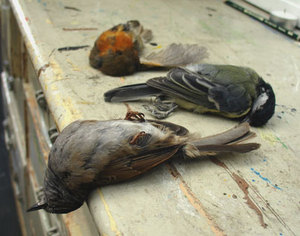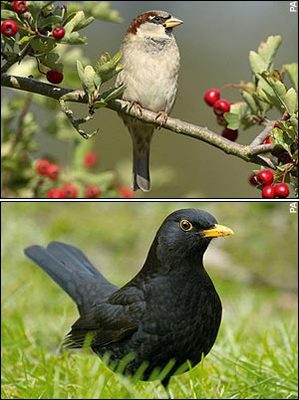
|
| ©Polly Morgan - The Drawbridge UK |
| Dead garden birds
Polly Morgan |
Although familiar names such as house sparrow, starling, blackbird and robin still appear regularly in our gardens, long-term their numbers continue to decline.

|
| ©Unknown |
The house sparrow (top) and the blackbird (bottom) were both in the top ten garden birds
The RSPB's 2008 Big Garden Birdwatch results shows another steep drop in the average number of once common birds seen in each garden.
In the 2004 survey an average 34.8 birds were seen per garden but this year numbers slumped to 28.4 birds.
Since the survey began in 1979 starling numbers have fallen by 77 per cent, house sparrow by 64 per cent, blackbird 39 per cent and robin 37 per cent.
Although some species are in long-term decline others are not using our gardens to find food because they are able to forage successfully in the wild. In milder winters birds don't have to rely on scraps from the bird table to stay alive.
Despite its decline - thought to be due mainly to loss of gardens and suitable nesting sites in modern houses - the house sparrow retained its top spot in this year's Birdwatch survey with an average of 3.60 birds per garden.
The starling finished in second place with 3.44 birds and the blackbird in third with 2.45.
The biggest success story this year was the finch with four species who spend the winter in the UK increasing and the goldfinch entering the top 10 list - at number 10 - for the first time.
And its smaller cousin the siskin made it into the top 20 for the first time in Birdwatch's 29 year history being seen in three times as many gardens as in 2007. The survey shows that over the last five years siskin numbers have increased by almost two thirds.
Elswhere the ubiquitous and cumbersome woodpigeon continues to make a good living out of urban gardens as does the collared dove. Blue tit numbers suffered because the wet Spring deprived them of an ample supply of caterpillars to feed their young.
Almost 400,000 people tookpart in Big Garden Birdwatch over the week-end of January 26/27 counting more than 6m birds from 50 species over 228,000 gardens.
Dr Andre Farrar, of the RSPB said: "It's definitely been a good winter for finches. Many of them are here because of food supplies. The increase in bramblings, up by two thirds in the last five years, reflects the scarcity of beech seed known as 'mast' in northern Europe and Scandinavia - if the mast crop is poor in these countries, we see more of them here in our gardens.
"Along with siskin increases, numbers of redpolls seen in gardens have skyrocketed. Again this is probably due to supply of food; both birds feed on conifers and deciduous seeds, so the figures suggest that tree seed supplies have been poor this year and they've been forced into gardens to find food."
Of the colourful and distinctive red-faced goldfinch he said: "We're seeing numbers of goldfinches swell because our milder winters encourage them to stay here instead of going to southern Europe. Our gardens can be very welcoming to finches, especially those with nyjer seed provided and thistles and teasels left to grow which also provide food."
One welcome feature was the increase in the number of song thrushes with numbers up almost 80 per cent on last year. It thrived probably because the warm, wet summer provided a plentiful supply of snails, slugs and earthworms.
Even so the song thrush has suffered a decline of almost two-thirds in the past 30 years and is on the Red List of endangered species.
Visit the RSPB website www.rspb.org.uk/birdwatch for the full UK-wide Big Garden Birdwatch results.



Reader Comments
to our Newsletter